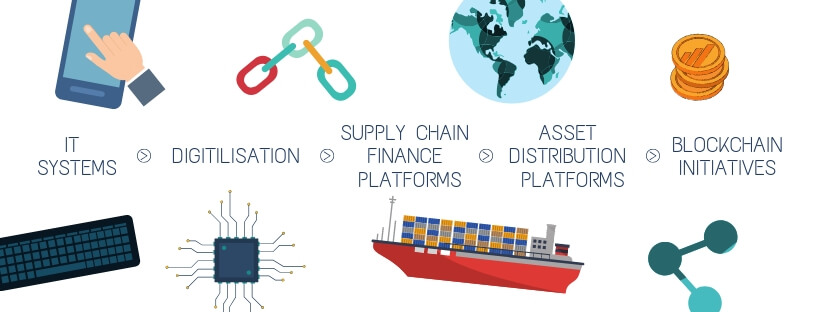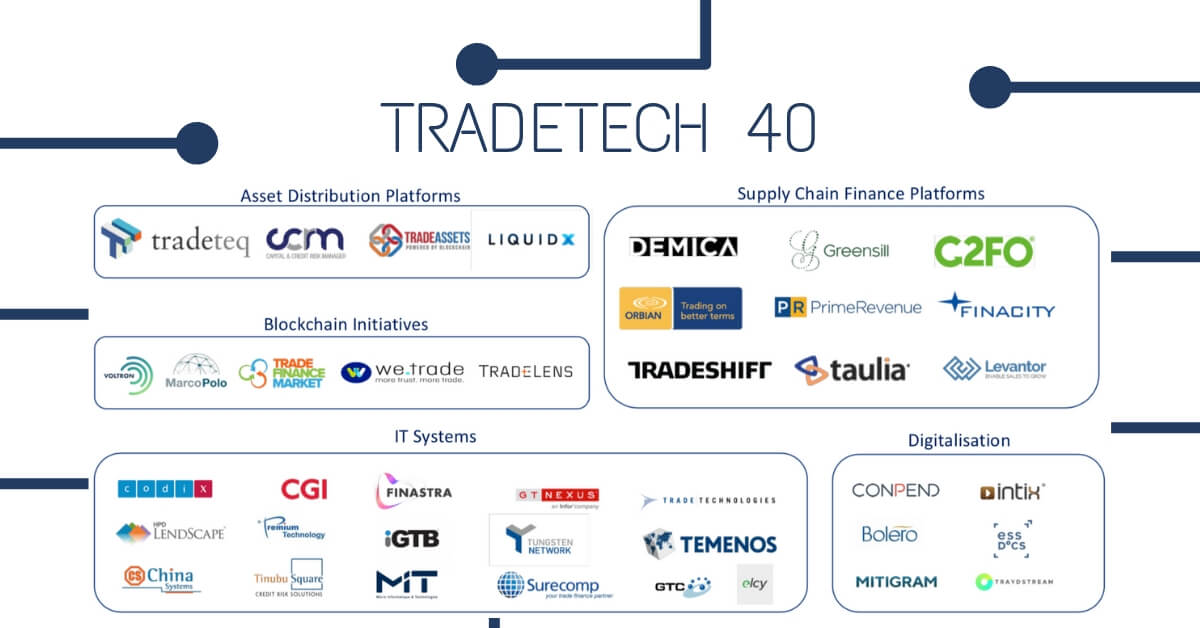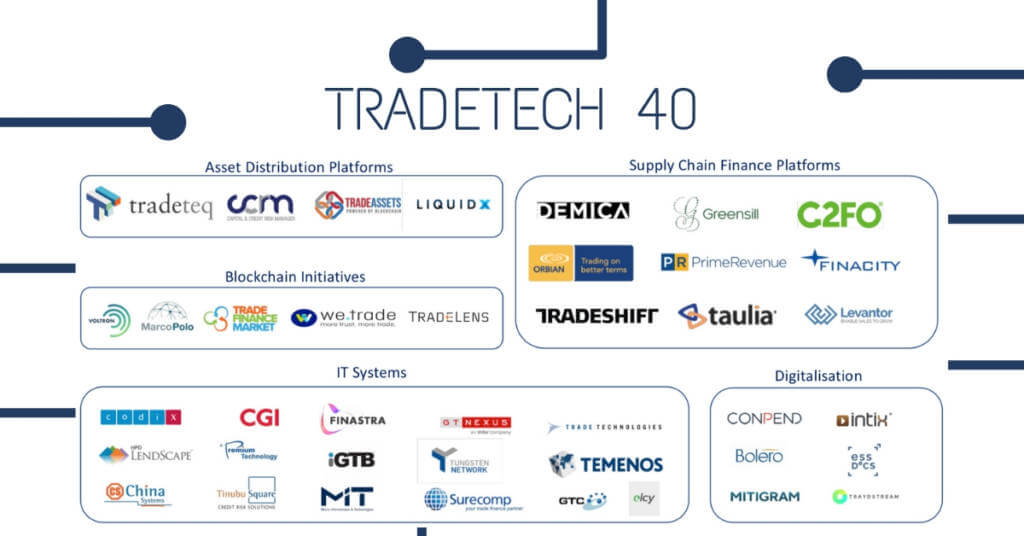In the way that “Insurtech” and “Regtech” have developed in recent years, a new wave of fintech is trending – that of “Tradetech”. Trade Finance Global investigates the Top 40 rising fintechs supporting international trade.
What is “Tradetech”?
As cross-border trade has digitalised, so an ecosystem has built up to support it – especially with respect to trade and supply chain finance, although also around logistics and in connecting key parties in the cross-border supply chain. Given this, the Tradetech 40 for the first time brings together this rising fintech sector’s leading companies and initiatives – representing every aspect of the technological advances being made to support today’s international trade.
The Tradetech 40 includes names that are instantly recognizable – such as Demica, Finastra (a merger of D+H and Misys) and China Systems. Yet it also includes initiatives such as Marco Polo (a trade network connecting banks, corporates and third party providers) as well as relatively new players such as Tradeteq (a trade finance assets marketplace) and TradeLens (a blockchain based platform jointly developed by Maersk and IBM).
The Tradetech 40 looks across the sector – grouping the companies and initiatives by their offering into five categories. These are: IT systems, asset distribution platforms, supply chain finance platforms, blockchain initiatives and those aiding the digitalisation of trade.
The Evolution of Tradetech
In terms of a timeline, IT systems began to revolutionise how banks offered trade finance back in the 1980s with the digitalisation of some trade finance processes beginning in the1990s (via initiatives such as Bolero). Supply chain finance initiatives also date back to the 1990s though only make a market impact after 2000. More recently, the market has seen the emergence of asset distribution platforms, which have helped attract new pools of liquidity into the trade finance market, while the blockchain phenomenon’s impact is only just starting to be felt.

IT systems
China Systems was one of the first IT systems developed specifically for the trade finance market. Stretching back to 1983, it developed Trade Finance and Payments Solution, a Java EE-based back office solution for trade and supply chain finance, open account, and payments transactions. The company also developed an integrated system that automated and audited the complete cycle of trade finance, open account, and payment transactions in real time.
Digitalisation
Then came the era of digitalisation. Providers such as Bolero developed solutions enabling financial institutions to offer buyers and sellers the ability to digitalise and automate their accounts payable and receivables processes. Purchase orders, invoices and other trade documentation became available for electronic uploading and automatic validation, processing, matching and approval.
Supply chain finance platforms
In 2006, Demica launched Citadel SCF, an innovative supply chain finance tool bringing unprecedented cash-flow benefits to buyers and suppliers, as well as a simple, automated transaction management solution for financiers.
Citadel SCF streamlines the execution of a supply chain finance solution through the complete automation of the financing process. It provides a transparent window into the financing process, giving the buyer, supplier and lender the capacity to track individual invoices, payments and final settlements in real time.
Asset distribution platforms
An obvious step but one that took time to win traction has been the advent of asset distribution platforms. Complementing the trade finance syndications teams within banks, these focus on marketing sellable trade finance assets, mostly originated by banks (as well as some alternative providers). Yet the technology here is not simply focused on a buy-sell trade. It is on helping the trade finance market overcome a major hurdle to the wider distribution of assets – the problem with credit scoring trading entities. Innovative companies such as Tradeteq have developed AI-driven technology that overcomes the complex credit risks associated with trade finance – allowing new sources of liquidity to invest in trade without the need for expensive credit analysis teams.
Blockchain initiatives
Complementing the digitalisation of asset distribution in trade finance is blockchain technology, which can greatly simplify the direct transfer of trade assets while increasing confidence in their provenance. This is achieved through providing unique, non-forgeable identities for assets, along with an inviolable record of their ownership. The result is an opportunity for additional financing services based on the trade of physical goods – an example of which is Marco Polo. This is a banking initiative for trade finance powered by R3’s blockchain technology.
Who are the Tradetech 40?
Tradetech 40 Interviews and Features
New Deutsche Bank and Kodex AI whitepaper shows Gen AI’s potential for banking
0 CommentsSwift, Euroclear, and major financial institutions collaborate on Chainlink to digitalise asset servicing
0 CommentsNew digital trade “China corridor” brings transaction time from Europe down to hours
0 CommentsBexNote: The nascent digital revolution in bills of exchange
0 CommentsDigitalisation from end to end: Lloyds Bank trade insights
0 CommentsMonthly TFG & ICC DSI Column
0 CommentsVIDEO | ITFA Cyprus: The 6 hottest topics in trade and supply chain finance right now
0 CommentsSupply chain industry leaders back push towards electronic bills of lading
0 CommentsWhat’s next?
Of course, the Tradetech sector is constantly updating itself, meaning that the Tradetech 40 of 2018 will not be that of 2019, and certainly not that of 2029. What is clear from recent initiatives is that these five elements will somewhat converge. Even now, they are learning to collaborate – as initiatives such as Marco Polo attest. Another likely innovation will be a more direct role for the banks. While many are involved in critical digitalisation initiatives (such as the development of the electronic Bank Payment Obligation or BPO), they have so far collaborated with specialist IT providers rather than taken the lead. Leaders in this space – such as Deutsche Bank, UniCredit and Citi – will increasingly look towards proprietary solutions, however.
Certainly, from an industry perspective, to increase the impact of Tradetech in the trade finance industry, these 40 companies and initiatives should make a concerted effort to work even more collaboratively – both with each other and with the more traditional players such as banks. If they can, the Tradetech 40 will soon become the Tradetech 100, and include some very familiar names indeed.






























